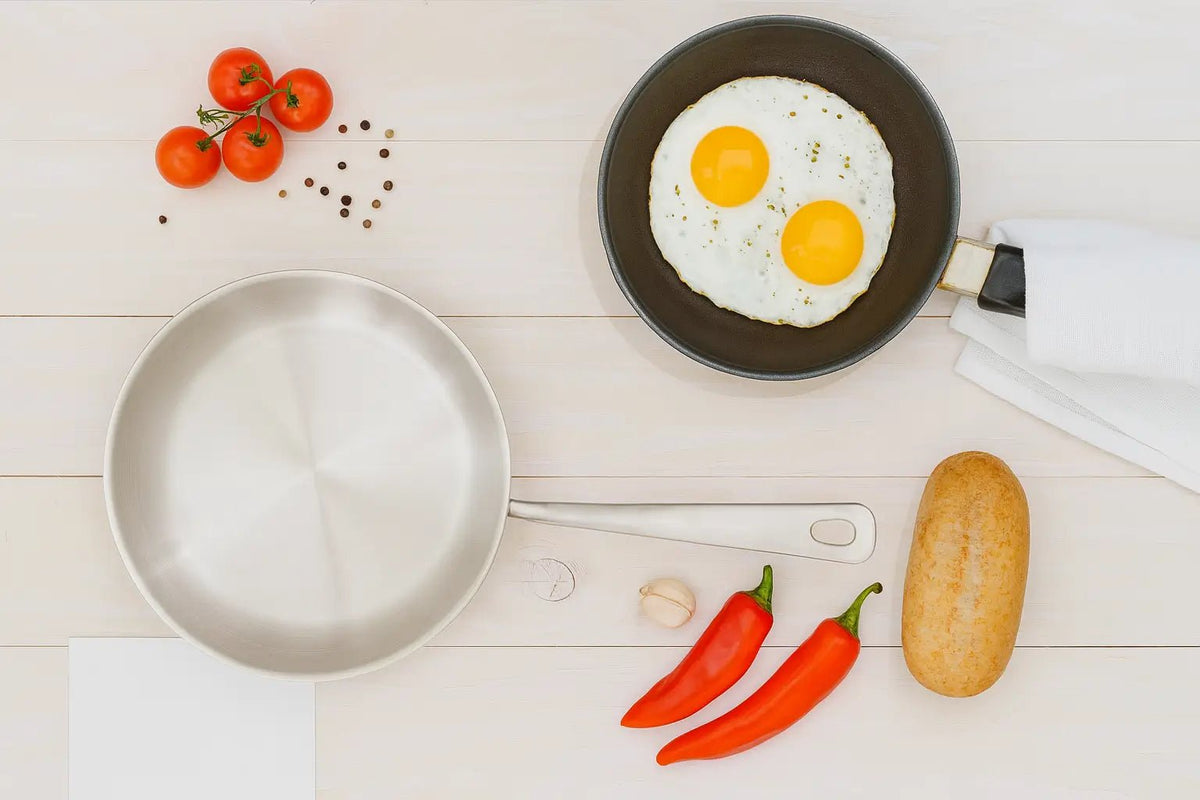

Choosing cookware isn't just about picking a pan—it's about selecting the right tool for the dish you're creating. Among the many options available, non stick and stainless steel cookware stand out as two of the most popular choices for a reason. Both offer unique advantages depending on what and how you cook.
Rather than choosing between them, the smartest solution might be to incorporate both into your kitchen. Each material brings something different to the table—non stick excels at simplicity and ease, while stainless steel shines with performance and versatility. This guide will help you understand the differences, allowing you to make informed choicesor simply confirm why having both is a winning strategy.
Table of Contents
Exploring Non Stick Cookware

When we talk about non stick cookware, we're typically referring to pans coated with a manmade layer that resists sticking. These coatings, whether traditional or ceramic, are specially engineered to repel oil and water, creating a smooth surface that makes it easier to cook sticky or delicate foods like eggs, crepes, or flaky fish.
This type of cookware isespecially popular for low-fat or oil-free cooking, as its slick surface allowsfood to be released easily without the need for much butter or oil. It's alsoone of the more accessible and affordable options on the market, although thequality and durability can vary significantly between brands and materials.
Advantages of Non Stick Cookware
- Reduced need for oil or butter: Non stick cookware allows for healthier cooking by requiring minimal fat, making it ideal for those watching their calories or fat intake.
- Quick and easy cleaning: Food releases easily from the surface, meaning you won’t need to soak or scrub the pan after use. Minimal sticking also means fewer. Great for beginners and everyday cooking: Non stick cookware is user-friendly, forgiving, and simplifies cooking delicate items like eggs or fish.
- Lightweight and versatile: Most non stick pans are easy to maneuver, making them a practical choice for daily use.
Challenges of Non Stick Cookware
- Shorter lifespan: Even with proper care, the coating on non stick cookware will degrade over time and require replacement.
- Not suitable for high heat: Prolonged exposure to high temperatures can damage the non stick coating and reduce its effectiveness.
- Requires soft utensils: Metal tools can scratch and peel the coating, so it’s best to use wooden, silicone, or plastic utensils.
Best Uses for Non Stick Cookware
- Cooking eggs, pancakes, or crepes without sticking.
- Preparing delicate proteins like fish and tofu.
- Stir-frying or sautéing vegetables and low-fat meals.
- Everyday breakfasts or quick one-pan meals where cleanup is minimal.
Shop Non Stick Cookware
Exploring Stainless Steel Cookware

Stainless steel cookware is a favorite among chefs and seasoned home cooks for its exceptional performance and longevity. What sets it apart is its multi-layered construction, often combining stainless steel with metals like aluminum or copper, to deliver consistent heat distribution and control across the cooking surface.
Because it doesn't rely on any non stick coating, it's ideal for high-heat cooking methods like searing, browning, and deglazing. Its responsiveness to temperature changes makes it incredibly versatile, whether you're preparing a quick sauté or building complex sauces.
For a deeper look at its performance and everyday practicality, explore our stainless steel cookware guide.
Advantages of Stainless Steel Cookware
- Superior heat distribution and retention: With layered construction, stainless steel cookware heats evenly and maintains consistent temperatures.
- Highly durable and long-lasting: Resistant to scratches, dents, and corrosion, quality stainless steel can last for decades.
- Safe for high temperatures: Oven- and grill-safe, making it perfect for recipes that require searing, deglazing, or finishing in the oven.
- Non-reactive surface: Stainless steel won't react with acidic ingredients like tomatoes or vinegar, ensuring clean, authentic flavors.
Challenges of Stainless Steel Cookware
- Food may stick if not properly preheated: Learning how to preheat and use oil or butter properly can reduce sticking, but there's a slight learning curve.
- More effort to clean: Burned-on food or residue may require scrubbing or soaking to remove.
- Heavier than non stick: These pans are solidly built and can be a bit more challenging to lift or handle.
Best Uses for Stainless Steel Cookware
- Searing meats and browning: The metal's heat tolerance makes it perfect for creating a flavorful crust.
- Deglazing and pan sauces: Ideal for recipes that require developing fond and adding rich flavor layers.
- High-heat or multi-stage cooking: Can transition seamlessly from stovetop to oven.
- Boiling pasta, making soups, or reducing sauces that require even heat control.
Shop Stainless Steel Cookware
Stainless Steel vs. Non Stick: How Do They Compare?

Choosing between non stick and stainless steel cookware isn't just about preference—it's about function, durability, and the type of cooking you do most. Below is a detailed comparison to help you evaluate which cookware type aligns better with your kitchen needs or why both deserve a spot in your collection. And if you're asking yourself, is stainless steel better than non stick?—the answer depends entirely on how and what you cook.
Heat Distribution and Retention
Stainless steel cookware, especially when layered with aluminum or copper cores, offers excellent heat conductivity and retention. It heats evenly across the cooking surface, which helps avoid hot spots and ensures consistent cooking—making it a favorite for tasks like browning meat or simmering sauces.
Non stick cookware, on the other hand, heats up faster and can be more energy-efficient. However, it generally lacks the same level of thermal conductivity as stainless steel, and it tends to underperform when used for prolonged high-heat cooking. As a result, it may not be the best choice for tasks that require sustained heat or precision temperature control. Since it struggles under high temperatures, it's best reserved for simple dishes that don't require intensive cooking techniques.
Cooking Versatility
Stainless steel cookware shines in versatility. It can handle everything from searing and sautéing to oven-roasting and broiling. Its ability to go from stovetop to oven makes it especially useful for recipes that involve multiple cooking stages.
Non stick cookware is better suited for specific, gentler tasks. It excels at cooking sticky or delicate items like eggs, pancakes, and fish. While some high-end non stick pans are oven-safe to moderate temperatures, they're not designed for high-heat or abrasive techniques.
Durability and Longevity
Stainless steel cookware is designed for long-lasting use. With proper care, it can last for decades and withstand heavy use without warping or degrading. Its scratch-resistant surface can handle metal utensils and aggressive cleaning, making it a staple in professional kitchens.
Non stick cookware, on the other hand, typically has a shorter lifespan. Even high-quality non stick pans begin to lose their coating after a few years of regular use. Exposure to high heat, use of metal utensils, or frequent dishwasher cycles can all accelerate this wear.
Maintenance and Cleaning
Non stick cookware is the go-to for easy cleanup and comes out head and shoulders above stainless steel in this category. Thanks to its slick surface, food residue is wiped away with minimal effort. This makes it perfect for quick meals and everyday use. However, it does require careful handling—no metal utensils or abrasive scrubbers—to preserve the coating.
Stainless steel requires a bit more maintenance but pays off in durability. Burnt-on food may require soaking or scrubbing with a mild abrasive, such as baking soda. However, it's dishwasher-safe and doesn't require the delicate handling that non stick surfaces demand.
Do You Need Both? Stainless Steel or Non Stick

If you're weighing your options between non stick and stainless steel cookware, here's the truth: both have valuable roles to play in your kitchen. While it's possible to rely on just one type, owning both gives you greater flexibility and ensures you're always using the right tool for the job.
Non stick cookware is unbeatable for everyday tasks—quick breakfasts, delicate dishes, or low-fat meals with minimal cleanup. Even if you only use it for morning omelets, you'll be glad it's there.
Stainless steel, on the other hand, is your go-to choice for high-heat techniques, browning, and recipes that require layering flavors or finishing in the oven. Its durability and versatility make it a long-term investment in your cooking routine.
So, if your budget allows, investing in both stainless steel and non stick cookware is a practical decision that enhances your kitchen's capabilities and your confidence as a cook.
Final Thoughts
When comparing stainless steel vs. non stick, it's not always about choosing one over the other—it's about using each where it shines. Non stick cookware is perfect for low-effort cooking and cleanup, while stainless steel cookware excels at high-performance techniques and durability.
By understanding the advantages of non stick cookware and the benefits of stainless steel cookware—including heat distribution, maintenance, and cooking versatility—you can create a kitchen setup that matches your cooking style and supports every type of recipe.






